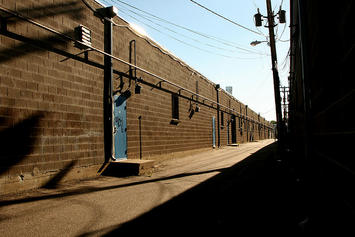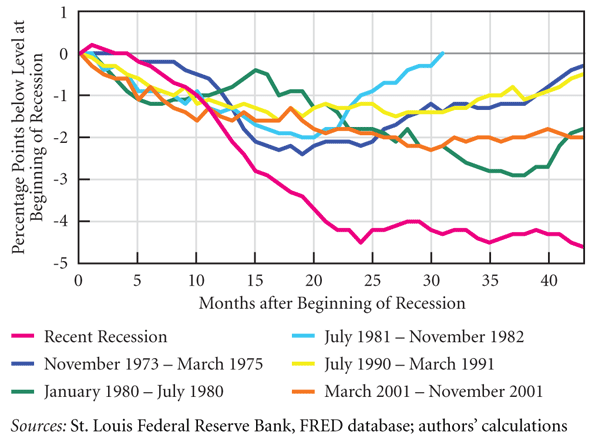
"By 1970, the governments of the wealthy countries began to take it for granted that they had truly discovered the secret of cornucopia. Politicians of left and right alike believed that modern economic policy was able to keep economies expanding very fast -- and endlessly. That left only the congenial question of dividing up the new wealth that was being steadily generated."
Those words, from a Washington Post editorial more than twenty-five years ago, echoed the beliefs not only of politicians and the press, but of mainstream economics professionals resistant to the idea that growth in a market economy would ever stagnate over a protracted period.
And some of the data did fit nicely. Through several recessions and recoveries, inflation-adjusted GDP rose almost in tandem with a line of predicted growth expectations. But in November 2007, something changed. Real GDP dropped down from what was expected by more than 11 percent, and, as this summer's data has shown, it hasn't returned to its pre-recession trend.
The unusual slump has provoked a stream of commentary that attempts to define the problem, but it hardly matters whether the downturn is identified as the second dip of a 'double-dip' recession, a continuation of the 'Great Recession', a fast-moving slowdown, a slow nosedive, a long-term stall-out, or a confirmation that the economy has entered a Japanese-style 'lost decade'. Growth during the 21st century is following a different trend line than it did in the 20th, and employment is also responding in new, different ways from earlier post-World War II recessions.
A range of additional data also indicates that what we're hearing is not the regular breathing of an economy as it contracts and expands. Annual growth rates and quarterly moving averages — when examined starting in the mid 1970s, as Greg Hannsgen and I did at the Levy Economics Institute — show a steady decline beginning in 2000.
And the employment numbers make the case yet again. Look at the graph below, with separate lines for the past six recessions. It traces employment-to-population ratios, beginning with the first month of each recession. These ratios are used to measure, among other things, how well a nation utilizes its workforce— a kind of labor drop-out rate.

You can see at a glance that the pink line indicating the current recession — yes, that one down near the bottom of the chart — is an outlier in the group. It shows that by the 43rd month of the downturn, the ratio stood at just over 58 percent, meaning that 58 percent of the population was employed. That figure is 4.6 percent less than at the recession's start, when more than 62 percent were working. And it means that this employment decline is steeper, deeper, and longer than in any of the previous five recessions by a long shot.
Even in the two worst recoveries during the past forty years, this ratio never before declined by more than three percent. By the time the five recessions were this far along, employment had returned either to pre-recession levels, or to a distance from the recession's start that was, at worst, two percent, compared to the current more than four percent.
Together, this data makes the case that we're in a prolonged slump that's highly unusual, and requires action that's far more aggressive than the usual responses. Job creation should be the government's urgent, first priority. The nation needs to recognize just how perilous the employment disaster is — and what a marked departure this recession is from any we've seen in the modern era.
Dimitri B. Papadimitriou is president of the Levy Economics Institute of Bard College, and executive vice president and Jerome Levy Professor of Economics at Bard.
Photo by mangpages: Recession 1













If you set out to make me
If you set out to make me think today; mission accomplished! I really like your writing style and how you express your ideas. Thank you.
Judi Tangkas Online
So luck to come across your
So luck to come across your excellent blog. Your blog brings me a great deal of fun.. Good luck with the site.
Terracotta warriors
i am for the first time
i am for the first time here. I found this board and I in finding It truly helpful & it helped me out a lot. I hope to present something back and help others such as you helped me.
web directory
Great things you’ve always
Great things you’ve always shared with us. Just keep writing this kind of posts.The time which was wasted in traveling for tuition now it can be used for studies.Thanks
https://www.youtube.com/watch?v=UIWc_kbAmls
I really appreciate this
I really appreciate this post. I¡¦ve been looking everywhere for this! Thank goodness I found it on Bing. You've made my day! Thanks again.
Victorino Noval
Wow, wonderful blog layout!
Wow, wonderful blog layout! How long have you been blogging for? you make blogging look easy. The overall look of your web site is fantastic, let alone the content!
Victorino Noval Producer
Packers and Movers Noida
It is your wish that you can go wherever you wish.
Packers and Movers Noida
Packers and Movers Navi Mumbai
Packers and Movers Thane
Packers and Movers Amritsar
Top 5 best recognized and skilled packers and movers.
Top 5 best recognized and skilled packers and movers companies in Jaipur, These are a renowned packers and movers moving companies in the Jaipur region also and well-known meant for excellence services.
packers and movers in jaipur
top 6 packers and movers marathahalli
Thanks for sharing good information about movers and packers this post.i appreciate your effort for do this work.packers and movers marathahalli bangalore
Local Packers and Movers India
There are several guidelines related to automated moving to be able to unique scenario and you will probably furthermore require a few papers and accreditation to be able to property your vehicle upon dangerous terrain.
Packers and Movers in Mumbai
Packers and Movers in Chennai
Packers and Movers in Delhi
Packers and Movers in Bangalore